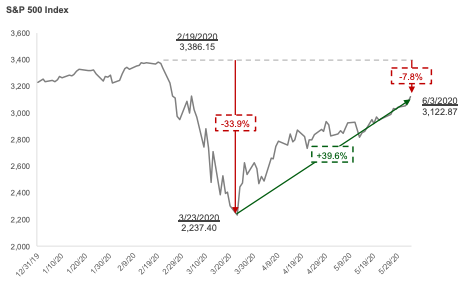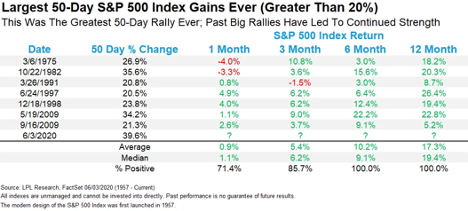05 Jun Rollercoaster Ride
It’s hard to imagine more of a rollercoaster ride for stocks than what we’ve experienced thus far in 2020. After declining by nearly 34% from its all-time high in February to its trough in late March (which included the market’s quickest ever move into a bear market), the S&P 500 has rallied ferociously over the last two-plus months. Over the last 50 trading sessions, the S&P has gained nearly 40% and now stands less than 8% from its all-time high.

According to data from LPL’s research team, the market’s rally of the last 50 days ranks as the best such rally in the S&P’s history since 1957, surpassing the rallies from mid-to-late 1982 and early 2009 by a few percentage points. What’s more is that big, short-duration rallies in the past have generally led to continued strength in the following months, as is evidenced in the table below.

Of course, there’s no assurance that this year will follow a similar trajectory we’ve experienced in the past, for if nothing else, this year has clearly demonstrated that unprecedented things can and do happen with more frequency than many of us likely appreciate.
Sources:
Best 50-Day Rally Ever, LPL Research Blog. June 4, 2020.
Important Disclosures
Kathmere Capital Management (Kathmere) is an investment adviser registered under the Investment Advisers Act of 1940. Registration as an investment adviser does not imply any level of skill or training. The information presented in the material is general in nature and is not designed to address your investment objectives, financial situation or particular needs. Prior to making any investment decision, you should assess, or seek advice from a professional regarding whether any particular transaction is relevant or appropriate to your individual circumstances. This material is not intended to replace the advice of a qualified tax advisor, attorney, or accountant. Consultation with the appropriate professional should be done before any financial commitments regarding the issues related to the situation are made.
The opinions expressed herein are those of Kathmere and may not actually come to pass. This information is current as of the date of this material and is subject to change at any time, based on market and other conditions. Although taken from reliable sources, Kathmere cannot guarantee the accuracy of the information received from third parties.
An index is a portfolio of specific securities, the performance of which is often used as a benchmark in judging the relative performance to certain asset classes. Index performance used throughout is intended to illustrate historical market trends and performance. Indexes are managed and do not incur investment management fees. An investor is unable to invest in an index. Their performance does not reflect the expenses associated with the management of an actual portfolio. No strategy assures success or protects against loss. There is no guarantee that a diversified portfolio will enhance overall returns or outperform a non-diversified portfolio. Diversification does not protect against market risk. All investing involves risk including loss of principal. Investing in stock includes numerous specific risks including: the fluctuation of dividend, loss of principal, and potential liquidity of the investment in a falling market. Past performance is no guarantee of future results.
S&P 500: Standard & Poor’s (S&P) 500 Index. The S&P 500 Index is an unmanaged, capitalization-weighted index designed to measure the performance of the broad U.S. economy through changes in the aggregate market value of 500 stocks representing all major industries.



